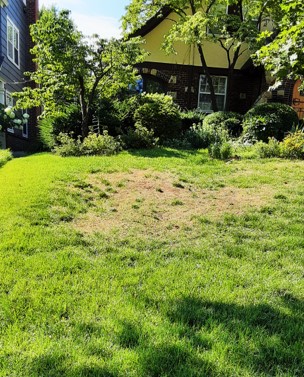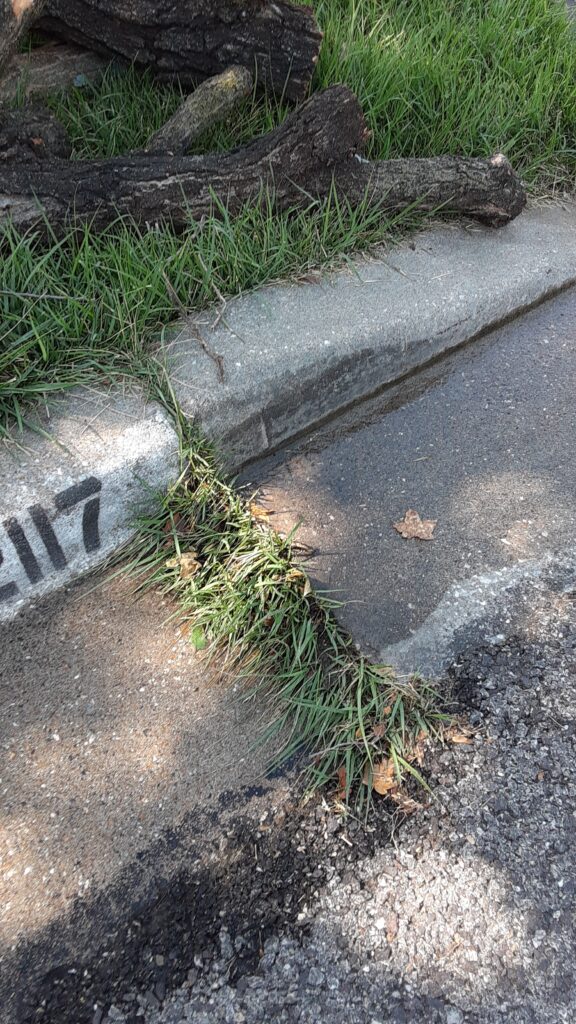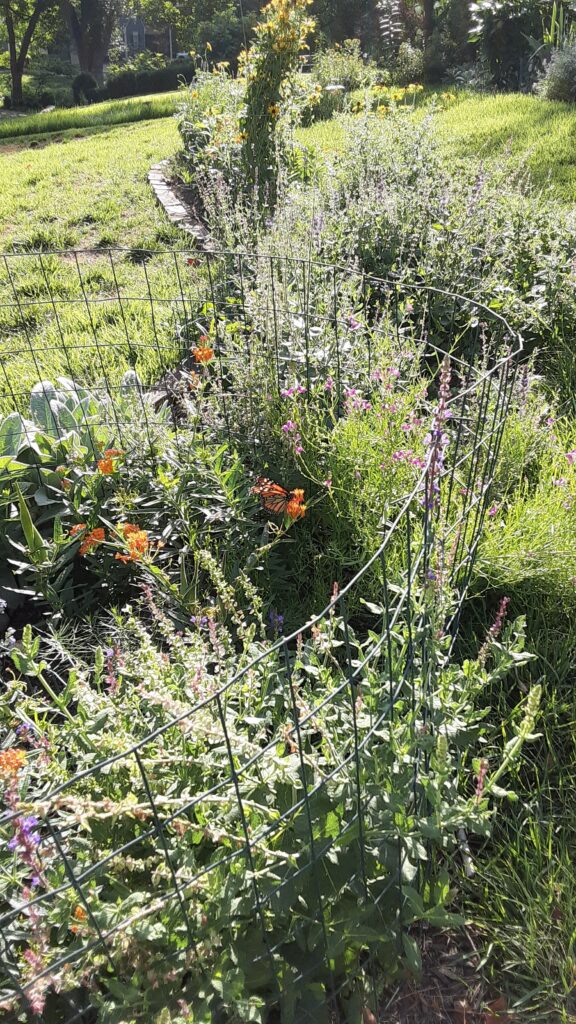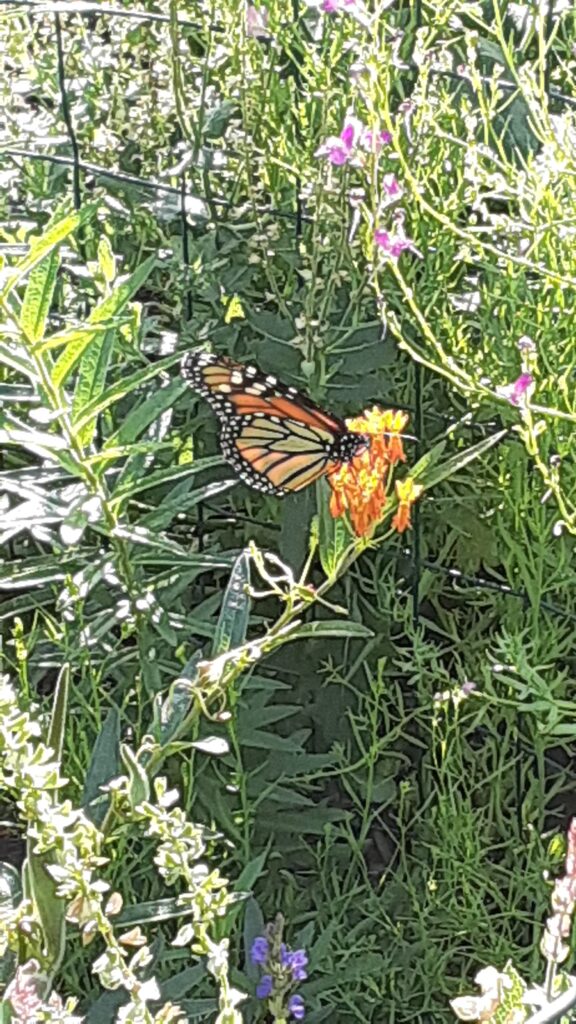Michael Pollan says the garden is more an arena than a refuge, and this month finds me facing off against a killer. My grass died. I don’t know why. It’s been green and growing—not spectacularly, but well enough—for the fourteen years we’ve lived here. Then suddenly, this summer, it died. What used to be lawn is a dirt patch overrun with rabbits and twitching with crickets. What happened?

Replacing lawns with plants with more ecological value or transforming them into meadows is much discussed these days and I love this idea, but for many of us getting rid of our lawn entirely isn’t a realistic option. We’ll always need to have some grass, even if it’s just mowed strips between the other plantings. I would like that grass to look good.
To start with, our lawn was mostly zoysia. It’s a tough turf, native to Korea, that was popular during the fifties and sixties when it was refined by the U.S. Department of Agriculture and the Professional Golfers’ Association (PGA). It spreads on runners, forming a thick mat over the driveway if I don’t cut it back regularly. It turns brown in the fall and greens up late, so each spring we worry it has died, but usually it thrives during the summer heat. The slope it covered is baking hot, which is supposed to be the perfect environment for it, but not this year.

Before I exert myself toward fixing this, I need to understand what happened. I headed to Soil Service. There I learned that zoysia is struggling throughout our area. In fact, Soil Service has a handout describing a problem called Zoysia Patch Fungus, complete with a picture that resembles our yard. However, one characteristic of Zoysia Patch Fungus is orange-colored patches, which I do not see. Nevertheless, I do think a fungus could be the killer.
A post about lawn fungus might not have broad appeal, but it is a problem many of us have ahd more will have if it keeps raining like it has been. I turned to Joe Lamp’l’s website, my go-to for information about organic gardening, where he has step-by-step instructions for how to renovate an existing lawn—which I will follow in September. The first thing he recommends is getting a soil test.
It’s always good to get more than one opinion, so I visited the Grass Pad (which, according to its website, has been selling Olathe’s best sod since 1983). It is far. But I was satisfied with the advice I received. I spoke with a guy named Dave, who had the air of someone who’s seen everything. When I ask a question, he hesitated before answering, “It depends.” I could imagine the flow chart of possibilities developing in the air over his Grass Pad cap. Do I want to reseed, or get rid of the zoysia altogether? If yes, I will need to get rid of the existing turf. If no, I can proceed to the next step.
Here is what I learned about renovating the lawn
- Now (August) is the time to prepare by destroying existing turf. See methods below.
- Renovation should begin in September. The window is September 1 – October 15, but the important thing is to avoid days with highs in the nineties. However, a few spikes into the nineties might not do much harm.
- Start by verticutting.
- Then fertilize. More on this later.
- Spread seed.
- Water one inch per week until established. Dave recommends using a sprinkler, not a hand-held wand, and that’s good for me because I’m looking at a large area.
Destroying the existing turf
The existing turf must be removed. Ways to do this include soil solarization, tilling, digging, and spraying with glyphosate, which is what most people recommend for a large area, like a lawn. I felt like a spy because I nodded while listening to Dave discuss the merits of different sprayers instead of telling him I would not do this. He prefers ones with metal nozzles.
However, whatever I’m fighting got rid of the grass for me—so I score! In some spots some grass still clings to life, but most of it is dead. In September, I can rake it away and move on to step three. I may not need to kill the fungus if I replace the zoysia with bluegrass or fescue (probably fescue for my dry, hot site).
Verticutting gives the seeds places to settle, which aids germination. The sprouts may look like a hair transplant at first, but eventually they will fill out.
This is all exactly what they told me at Soil Service, what Joe Lamp’l says, and what I already knew or suspected. I used to follow Soil Service’s Lawn Care Program and the yard looked great, but I stopped a couple years ago when I went completely organic. I took my leftover bags of Bug Blaster to the hazardous waste dropoff site and look what happened! Now I’m eager for September to come so I can start working on the lawn.


The bed across the front looks great, but I’m not making a compelling argument for gardening with native plants if the yard is ugly and the grass is dead.
Soil Service does have a “natural” program that uses organic products, so I guess I’ll try that next year.
I’ll keep you posted on my progress. Thanks for reading!
